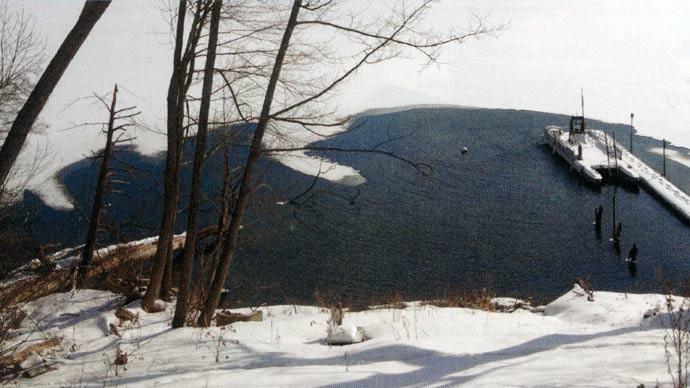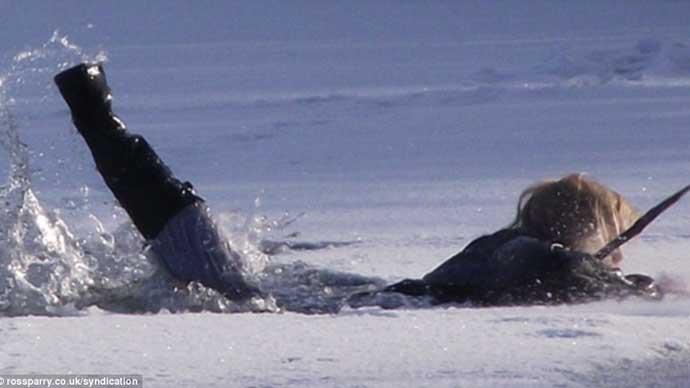
It can be tragic when you fall through it and exceptional when you are fishing under it.
Ice fishing takes anglers into a whole different world than what we southerners know. Our northern friends tolerate summer...to get to winter. Where anglers drag sleds, ice houses, or portable shelters loaded with gear that a southerner never sees, across a sheet of ice to a spot they've scouted before, to fish through a hole with scaled-down rods the size of my neighbor boy's Snoopy rig, reels, and line. When ice forms over fishing water, summer, boats and topwater lures are long gone. Nevertheless, once the ice is sufficiently thick to support the weight of fishermen and gear, numerous anglers venture out, knowing ice fishing can be one of the most rewarding times to fish, especially in small lakes and ponds.
At first glance, a novice ice angler thinks that fishing a frozen pond or small lake is easy. How hard can it be? Just drill a bunch of holes in the ice, drop a minnow in, and then wait for a bite. Experienced ice fishermen know better.
Ice fishing requires preparation and angling skills, just like in open water. Technology and equipment also play a vital part in ice fishing success. Ice fishing does have some inherent dangers. "Anglers should always carry or wear a pair of spikes around their neck to pull themselves out if they fall through the ice and wear a personal floatation device," said expert ice fishing guide Brian Brosdahl. Brosdahl strongly recommends other important equipment for ice fishing: a small auger, chisel, ice scoop, cleats on your shoes for footing, handheld GPS unit, flasher, and either a sled or portable shelter.
Don't forget the insulated underwear, snowsuit, hat, and insulated gloves.
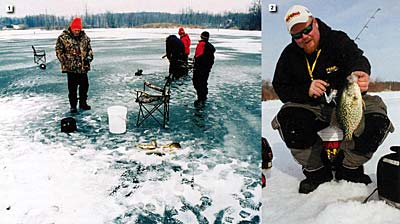
Just like in open water, locating fish is the key to catching them. Brosdahl suggested that anglers take some time to scout the lake before it ices over, marking brush piles, ledges, points, structure, and unique features with a handheld GPS unit so that they can go back to them once the ice forms. Another way to locate fish is to use a flasher. An angler walks around the pond, putting water and the transducer on the ice to locate fish or structure that holds fish. In some situations, anglers can walk around looking down through the ice, sight fishing if the water clarity is adequate. Brosdahl usually looks for schools of fish or small groups holding around habitat or structure. "I have found weeds can be extremely productive when ice fishing," said Brosdahl. Once the fish are located, anglers can fish one hole at a time or utilize multi-lines with tip-ups depending on state regulations. Brosdahl prefers to fish a jig in one hole holding his rod and use live bait on his tip-ups. "A couple of good things about ice fishing are that wind is not a factor, you do not have to unload or load a boat, and normally the equipment will cost less," explained Brosdahl.
Similar to open water fishing, ice fishing requires specific tackle. Ice anglers have their favorite artificial lures. Unlike open-water anglers, though, ice anglers will often tip the hooks of their artificial lures with live bait. Popular lures include small 1/32-ounce to 3/8-ounce spoons, puppet minnow (a hard minnow-shaped bait with a hook located on each end.), tiny ice jigs, or small soft plastic lures that resemble insects or other forage. As for live bait, ice anglers like to use maggots (they call them 'spikes' to ease the stigma of the word 'maggot'), wax worms, crappie minnows, and fathead minnows. Spikes can come in a variety of colors, too. This live bait can be purchased in tackle stores.

Other tackle an anglers needs is ice fishing rods and reels. Ice fishing rods and reels are designed for vertically fishing ultralight jigs or live bait, not casting. They have extremely light action tips that indicate soft strikes but enough backbone to handle the majority of fish swimming in any pond. Typically, ice fishing rods measure 18-inches for sight fishing, up to 32-inches with a quick tip for all other applications. Most ice fishing reels are small enough to fit in your hand and have an inexpensive, simple drag system. What test fishing line anglers use depends on what size fish they plan to catch. For the most part, anglers use 2, 3, and 4-pound test monofilament with smaller finesse style lures or bait and 5, 6, or 8-pound test monofilament with larger lures. Some people select braided line when fishing in water 20-feet or deeper to increase sensitivity.
Ice fishing has changed over the years due to advancements in sonar technology. Not only are anglers using flashers or digital sonar, but they are also relying on visually seeing the game fish on underwater cameras. That's all the rage in some areas. Drill a hole, scoop out the ice, drop a camera and look for fish. According to the latest statistics, over 70% of all ice anglers have flashers, and 35% have underwater cameras. Color flashers are probably the most popular because it shows real-time information, the fish, and lure instantly at the same time. Since locating the fish is the key, anglers will take flashers or digital sonar units and shoot through the ice, checking areas where game fish typically hang out. High percentage areas are around brush piles, grass, points, and breaks, just like in the summer months; however, it's better to find the fish before making a hole since game fish in ponds naturally like to suspend in schools. While flashers and digital sonar units have been available for years, high-quality underwater cameras are somewhat new to the marketplace. There are several advantages of using an underwater camera over a flasher. The number one advantage is you can look right at the fish and know what type and size it is. Other advantages include seeing how the fish are relating to cover and watching the bait so you can set the hook when a fish strikes it. Underwater cameras also give you more information than a flasher can in shallow water or in grass. New developments in battery technology have these cameras lasting longer than ever before. Plus, newer cameras gather more light in deeper water and low-light situations. Although anglers do not need or are required to have an underwater camera when ice fishing a pond, using them makes them worthwhile to have.
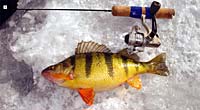
Productive ice fishing in ponds begins with building habitat that fish will use for protection and feeding. "Habitat varies in forms and is beneficial, whether commercially produced or man-made," explained fisheries biologist David Beasley, a long-time ice angler who works for Virginia Lake Management. While each pond is unique, placing habitat in them correctly will increase an angler's opportunity to catch fish when ice covers the pond. "Since ice freezes around the shore, productive habitat should be located off the bank. In general, productive habitat will be placed eight to ten feet off the bottom but not more than three feet to the surface. This habitat should be clustered together in one area; if there is too much habitat spread out, it has a negative effect on fishing. The fish will spread out and not be located in specific areas. Another thing an angler should do when placing habitat in ponds is keep the brush or cover off the bottom to keep it from silting in. The habitat should have places for smaller baitfish to hide and stumps or large boulders that create shadows for larger fish to ambush prey," said Beasley.
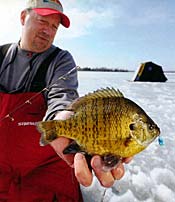
For anglers fishing ponds after the ice is safe enough to walk on, the challenge begins by locating critical areas to fish. "Just like in summer, in the winter, the water will turnover. As long as the ice stays clear and sunlight can penetrate, the pond will maintain good water quality; however, if snow builds up on the surface and no sunlight penetrates, water quality will become a problem," explains Beasley. Assuming water quality is not an issue, Beasley said, "Anglers should focus on travel routes in the pond that fish use day-to-day." Travel routes differ from seasonal migration patterns. A travel route could be a ditch, trench, depression, or a creek channel. Travel routes are used daily as fish move around to feed while seasonal migration patterns move fish according to water temperature or reproduction cycle. Why is this important to anglers? Although ice anglers are not limited to certain areas unless they are frozen, they still have to drill through the ice before fishing, and that takes time. If an angler finds key areas that have habitat close together with a travel route connecting them, they can focus on fishing that area to catch fish.
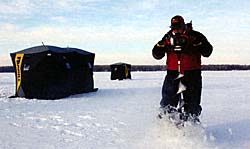
Ice fishing in ponds is as complicated as the angler makes it. An angler can have a limited amount of tackle and gear or a sled full. Technology can make a fishing trip to the pond more successful. Imagine watching the camera's screen while preparing to set the hook on a fish biting your lure or live bait. It can be fascinating. Like open water, the total experience is not just about catching fish. It's about the gear, scouting the fish, finding them, and then figuring out what it takes for them to bite. For many anglers, the ultimate reward is a fillet from a freshly caught fish. This tasty delicacy makes it all worthwhile enjoying the harsh, cold winter months and the thick ice covering their ponds until the spring thaw.
Reprinted with permission from Pond Boss Magazine



